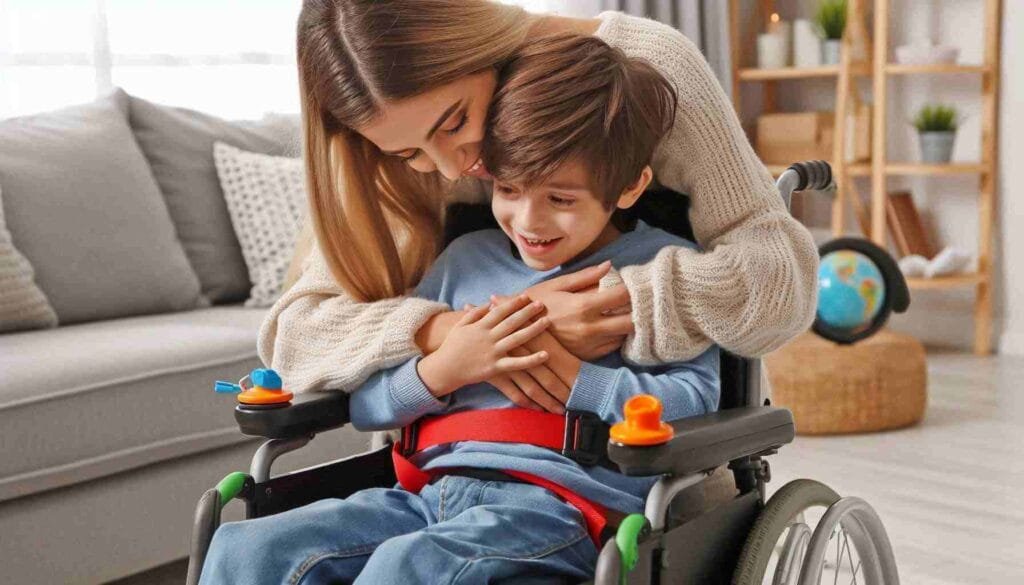Finding the right terminology to describe children with special needs is important for understanding and respect. The term “special children” can be replaced with phrases like “children with exceptionalities,” “children with special needs,” or “children with unique abilities.” Using the right words helps to give these children the dignity and respect they deserve.
Language is a powerful tool in shaping how we think about and treat others. By using positive terms, you can help foster a more inclusive community. This inclusion promotes diversity and ensures that every child’s unique condition is recognized and valued.
Various terms help describe the diverse abilities and needs of special children. For example, some might refer to them as “children with disabilities” or “differently-abled children.” These terms aim to highlight the strengths and individuality of each child rather than focusing on limitations.
Key Takeaways
- Correct language fosters respect and dignity for special children.
- Positive terminology promotes inclusive communities and celebrates diversity.
- Various terms like “children with special needs” and “differently-abled children” emphasize individual strengths.
Understanding Special Needs
Special needs encompass a wide range of physical, mental, and emotional challenges that can affect daily life. Understanding these needs helps in providing the right support and care.
Defining Disability and Special Needs
Disability refers to a condition that limits a person’s physical or mental abilities. It can affect activities like walking, seeing, hearing, or learning. Disabilities may be present from birth or acquired later in life.
Special needs is a broader term. It includes all disabilities and other conditions that require special attention, like autism or ADHD. The goal is to accommodate these needs through tailored education, healthcare, and social support.
Conditions Classified Under Special Needs
Conditions under the special needs umbrella can be divided into several categories:
- Developmental: Includes autism, Down syndrome, and cerebral palsy.
- Learning: Includes dyslexia and ADHD.
- Mental Health/Behavioral: Includes anxiety disorders and oppositional defiant disorder.
- Medical: Includes chronic illnesses like epilepsy and diabetes.
Each condition requires individualized care and support to help the person achieve their full potential. Special education programs and therapies often play key roles.
Prevalence and Occurrence in Society
Approximately 18.5% of U.S. children are estimated to have special needs. This includes both visible and invisible disabilities. One in every 59 children has autism spectrum disorder (ASD), a developmental disability.
These figures highlight the importance of awareness and the need for resources in schools and communities. By understanding the prevalence, society can better support individuals with special needs and work toward creating inclusive environments.
Different factors like genetics, environment, and prenatal care contribute to the occurrence of these conditions. Early diagnosis and intervention are crucial in managing and supporting children and adults with special needs.
Terminology and Language

Understanding the language used for describing special children is crucial. It affects how they are perceived and can either empower or marginalize them.
Evolving Language in Disability Discourse
Language around disabilities is always changing. In the past, terms like “handicapped” were common, but they are now outdated and seen as offensive.
Nowadays, there’s a push to use terms that respect the identity of the person. For example, instead of “autistic child,” some prefer “child with autism” to emphasize the person first. Terms like “neurodiverse” are also becoming more popular to describe a range of neurodevelopmental conditions.
Creating respectful language requires continuous learning and awareness of the preferred terms by the community affected.
Synonyms and Euphemisms for Special Needs
There are many synonyms and euphemisms used to describe children with special needs. Some of them include:
- Differently-abled
- Exceptional
- Neurodiverse
- Special needs
These terms aim to highlight the abilities and potential of these children rather than focusing solely on their limitations.
Yet, while some people see value in these euphemisms, others argue they can be patronizing. It’s essential to be mindful of how these terms are received by the individuals they describe.
The Problem with Ableist Language
Ableist language refers to terms and phrases that marginalize people with disabilities.
Terms like “crippled” or “lame” are examples of ableist language and should be avoided. Even well-intentioned phrases like “overcoming disability” can be problematic because they imply that a disability is something to be defeated.
Using inclusive and respectful language fosters a more supportive environment. You can contribute positively by avoiding ableist terms and using language that respects the identity and humanity of all individuals.
Rights and Access to Education
Students with disabilities have specific legal rights and access to education through special education programs and Individualized Education Programs (IEPs). These rights ensure that students receive the support they need to succeed in school.
Legal Rights of Students with Disabilities
The Individuals with Disabilities Education Act (IDEA) is a crucial law that supports students with disabilities. This federal law ensures that children from birth through age 21 receive free appropriate public education (FAPE). Under IDEA, a student with a disability is entitled to specially designed instruction and related services at no cost.
Additionally, Section 504 of the Rehabilitation Act and the Americans with Disabilities Act (ADA) protect students from discrimination based on disabilities. These laws necessitate reasonable accommodations to provide equal access to educational programs and activities.
Special Education Programs and IEPs
An Individualized Education Program (IEP) is a customized plan developed for each student with a disability. The IEP outlines specific educational goals and the services necessary to meet those goals.
IEPs are developed by a team that includes teachers, parents, school administrators, and sometimes the students themselves. They include goals and short-term objectives, the type of special education services, and the setting in which these services will be provided.
Under these programs, your child receives tailored support such as speech therapy or occupational therapy, helping them achieve their educational goals.
Community and Parental Support
Support for special children comes from both community resources and dedicated parental involvement. You’ll learn about the vital role parents play and how inclusive communities can make a difference.
The Role of Parents and Caregivers
Parents and caregivers play a significant role in the lives of special children. They often become the primary source of support and advocacy. This involves understanding the unique needs of their child, finding appropriate resources, and making informed decisions.
You might need to attend regular meetings with healthcare providers, teachers, and therapists. Emotional strength and resilience are crucial, as they help you to better navigate the challenges that arise. Joining parent support groups can also be beneficial, offering a space to share experiences and strategies.
Effective advocacy starts at home. You need to communicate clearly with everyone involved in your child’s life. Being organized and staying informed about local and national resources can alleviate stress. Remember, your involvement directly impacts the well-being and progress of your child.
Building Inclusive Communities
Communities can also provide substantial support for special children. Inclusive communities offer activities, programs, and policies designed to accommodate diverse needs. Schools, parks, and recreational centers should strive to be accessible to every child.
You might look for community programs that offer special accommodations or trained staff. Some communities have specific events designed for special needs families, fostering a sense of belonging and acceptance. Additionally, online platforms like Mommies of Miracles can expand your support network beyond local boundaries.
Engaging in community activities helps to normalize inclusion, benefiting both special children and their peers. Your participation in advocacy and community planning can lead to better, more inclusive solutions for everyone involved. Collaboration between families, local businesses, and organizations is essential for creating an environment where every child feels valued and supported.
Health and Daily Living
Managing the health and daily living of children with disabilities involves multiple areas, including specific healthcare needs and the use of adaptive equipment. Understanding these areas helps ensure that your child can thrive.
Healthcare Management for Children with Disabilities
Children with disabilities often require specialized healthcare. Regular visits to healthcare providers help monitor their progress and address any new ailments or problems. Routine checkups can help manage conditions like asthma, diabetes, or epilepsy.
Medicaid’s Early and Periodic Screening, Diagnosis, and Treatment (EPSDT) program offers essential services. It provides preventative care, early diagnosis, and treatment options for low-income children under age 21.
Healthcare management is crucial for those with physical disabilities who may need specific treatments like physical therapy to improve mobility or medications for managing chronic pain. Additionally, children with intellectual disabilities may benefit from close monitoring by specialists to address developmental delays and behavioral challenges.
Adaptive Equipment and Accessibility
Adaptive equipment enables children with disabilities to navigate daily activities more efficiently. Items like wheelchairs, hearing aids, and communication devices can significantly improve the quality of life. Wheelchairs provide mobility for those unable to walk, while hearing aids assist children with hearing impairments in better understanding their environment.
Accessibility in the home and school is also vital. Ramps, wider doorways, and accessible bathrooms make spaces more accommodating for children who use wheelchairs. In educational contexts, accessible learning materials and assistive technology can support academic performance.
Parents and caregivers should consult with occupational therapists to ensure that the right equipment and modifications are in place to fit their child’s unique needs. This approach helps create a more inclusive and supportive environment.
Frequently Asked Questions
This section addresses various ways to describe and refer to children with disabilities respectfully and accurately.
What are alternative terms to describe children with disabilities?
You might hear terms like “children with special needs,” “children with disabilities,” or “students with exceptionalities.” These are considered more inclusive and respectful.
Which expressions are considered positive when referring to children with special needs?
Using terms like “children with special needs” or “students with disabilities” can be more positive. Avoid using derogatory or outdated terms.
How are children with unique developmental conditions typically classified?
Children with developmental conditions are often classified based on their specific needs, such as cognitive impairments, physical disabilities, or learning disabilities.
What is the current acceptable terminology for children who have special educational requirements?
The term “students with special educational needs” is widely accepted. It’s important to describe their specific needs rather than using vague or outdated terms.
What is a respectful way to address children with disabilities?
It is respectful to use person-first language, such as “a child with a disability” rather than “a disabled child.” This emphasizes the individual over the condition.
What terms are used to identify children with exceptional educational needs?
You might hear terms like “children with learning differences,” “students with diverse learning needs,” or “children requiring individualized education programs (IEPs).” These terms focus on their educational requirements.





